The COTS use in harsh Radiation environment of the CERN accelerators complex
- Posted by Ruben Garcia
- On November 22, 2019
- 0
Outline
- Introduction to R2E problematic in accelerators
- Accelerator radiation environment
- Radiation Hardness Assurance approach
- RADSAGA and RADNEXT
- Main takeaways
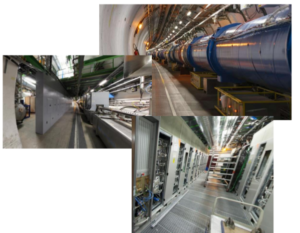 COTS-based critical equipment near the accelerator
COTS-based critical equipment near the accelerator
- Main reason requiring operation near accelerator:
- Cable distance to accelerator elements (magnets, vacuum, cryogenics, RF, beam instrumentation…)
- Lack of radiation-safe areas around accelerator (underground machine)
- Main drivers for use of COTS:
- Cost
- Performance
- Availability and timeline
- A typical example of system-level SEE requirement: one R2E failure per critical system per year
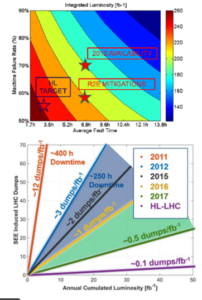 R2E impact on accelerator performance
R2E impact on accelerator performance
- Critical LHC systems are interlocked: their main function is to protect the machine integrity, therefore in case of the fault/spurious signal, the beam will be dumped (i.e. extracted from LHC in a controlled manner)
- An R2E event (soft/hard) can result in the loss of beam (turn- around time of 2-3 hours) and/or the need of access (further 3-4h of downtime)
- 0.1 dumps/Fb-1 involves an upper limit of 25 R2E dumps/year or roughly one per week of operation
- Given the number of critical systems exposed to radiation, this translates into an R2E failure budget of a few (2-3) per system and year – we consider one per year as a design requirement.
- If we consider the (realistic) case of 1000 units exposed to 109 HEH/cm2 /year, one failure per system and year involves:
- A unit failure rate of one in 1000 years* (MTBF of 2.8∙106 hours, or 350 FITs)
- A system-level SEE cross-section upper limit of 10-12 cm2 /unit
Detector environment and electronics
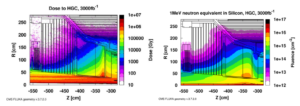
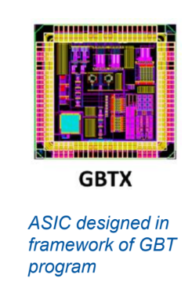 For the HL-LHC (High-Luminosity LHC) detector electronics, to operate between 2025 and 2035, radiation levels of up to 10 MGy (1 Grad) and 1016 neq/cm2 are expected, thus requiring the use of rad-hard by design electronics
For the HL-LHC (High-Luminosity LHC) detector electronics, to operate between 2025 and 2035, radiation levels of up to 10 MGy (1 Grad) and 1016 neq/cm2 are expected, thus requiring the use of rad-hard by design electronics
- Example of rad-hard design for high-energy accelerator detector electronics: Giga-Bit Transceiver (GBT)
- Started in 2007 as a rad-hard bi-directional optical link for the LHC detector upgrade program
- Data transmission between front-end detector, exposed to radiation, and back-end, in radiation safe area
- Radiation constraints: SEE-free, 1 MGy TID (and no DD limit as it can be neglected for CMOS)
- Qualification: X-rays for TID, heavy ions for SEE
- Timeline and cost for development & qualification are beyond the scope of systems for the accelerator sector
Accelerator environment
- The radiation levels in the accelerator span over many orders of magnitude (e.g. GGy irradiation of beam screens for material damage) but typically COTS-based systems are foreseen to operate in areas with levels below 200 Gy for ~20 years operation
- The 200 Gy limit is mainly motivated by (i) the relatively large amount of areas near the accelerator fulfilling this condition, (ii) the fact that selected COTS can be used up to such levels
- Importance of monitoring and simulating radiation levels in order to provide specifications for equipment groups designing and qualifying radiation tolerant systems

Accelerator environment – areas near Interaction Points

- Radiation levels near interaction points dominated by collision debris
- Expected TID and DD levels in the accelerator tunnel for system lifetime (~10-20 years) can reach 100 kGy and 1015 neq/cm2, therefore excluding the use of COTS
- Shielded alcoves (~40-200 cm of concrete/iron shielding) host electronic systems in this part of the accelerator, with HEHeq levels of 107 -109 HEH/cm2 /year, therefore posing a threat in terms of SEEs
Accelerator COTS system architecture

- COTS-based, but the custom design (i.e. full control of schematics and part selection). Use of COTS modules (black boxes) for critical applications in radiation is excluded.
- Front-end: no microcontrollers/DSP performing computationally intensive tasks, which are moved to the control system through a gateway, high availability rad-to communication between front-end and gateway required
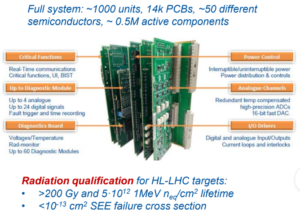 FGClite power converter controls system
FGClite power converter controls system
- Critical system to accurately control power converter current provided to LHC magnets
- Replacement of FGC2 system, which was radiation-sensitive
- Main design concept: lighter front-end, pushing part of the digital processing to radiation-safe areas (i.e. the importance of rad-tol, high- performance communication link)
- Modularity with a clear definition of critical/diagnostic functions
RHA for COTS-based systems
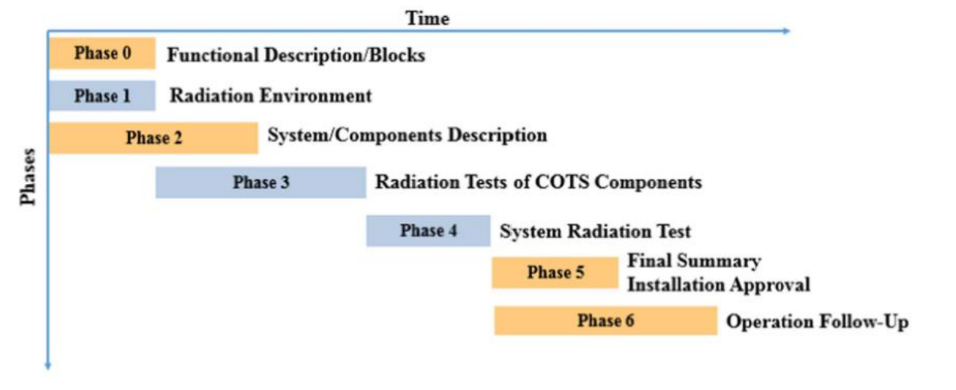
- Considering radiation tolerance constraints at a very early stage of the design
- Validation of radiation tolerance at the system level before final production
RHA for COTS-based systems

impact of a component failure at the system level
Not possible to test all parts at the same level, therefore different classes according to criticality need to be considered
Component level testing (at PSI)
- Component level tests typically carried out at PSI (200 MeV protons), covering all three effects (SEEs, TID, displacement damage)
- Typical annual figures for R2E at PSI: ~500h beam time, ~50-80 different COTS references tested
- Standard component level requirements: Destructive SEE free, a lifetime of 200 Gy and 2∙1012 neq/cm2

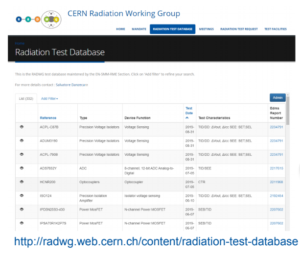 Component level testing: database
Component level testing: database
- Database with over 300 COTS component test report (mainly PSI: proton SEE, TID and DDD)
- Work-in-progress for defining and implementing access to reports for academic and commercial use
- CERN R2E mid-term strategy: being able to provide accelerator equipment groups with parts from tested lots (common batch procurement of components, appropriate storage, etc.)
System-level testing (at CHARM)
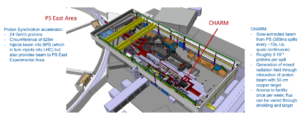
- System-level testing at CHARM:
- System-level testing is applied as validation under operational conditions and in representative radiation environment (i.e. the part selection & qualification, plus system-level mitigation have already been carried out beforehand, therefore system level validation is expected to be successful)
- Systems are built modularly and with self-diagnose capability, therefore in case of failures or errors at a rate larger than that specified, re-design without major changes is typically possible
- Typical weekly radiation levels (considering position R10 and 1.5∙1016 protons on target): 350 Gy, 2.5∙1012 neq/cm2, 7.5 ∙1011 HEH/cm2

Risk of use of COTS modules (black boxes)
- “Black box” approach, very low observability and no re-design possibilities
- Power MOSFET used in pre-regulator of power converter AC-DC
- Two MOSFETs of similar electrical specs but very different sensitivity

RADSAGA and RADNEXT
RADSAGA: an on-going Marie Curie training network of 15 student projects across Europe working on radiation effects for space, avionic, ground level and accelerator applications
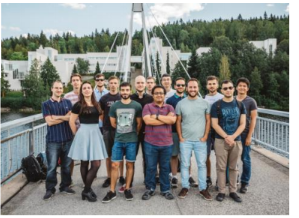
http://radsaga.web.cern.ch/
RADNEXT: an EU proposal in preparation for enhanced service and accessibility to irradiation beam time for research applications in academia and industry
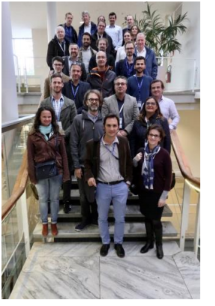
Interested partners and users can contact radnext-proposal-coordination@cern.ch
Presentation takeaways
- The CERN accelerator sector makes extensive use of COTS-based custom systems, operating successfully in radiation environment and with challenging availability and lifetime constraints
- High-reliability operation of COTS-based systems in radiation environments is possible in a cost-efficient manner, but relies heavily on:
- Consideration of radiation environment and specification of required tolerance at a very early stage of system definition (otherwise, a strong price is paid in terms of machine performance and mitigation measures)
- Centralized support for part selection, architecture definition and component & system level radiation testing
Recent R2E publications
- M. Brucoli et al., “Investigation on Passive and Autonomous Mode Operation of Floating Gate Dosimeters,” in IEEE Transactions on Nuclear Science, vol. 66, no. 7, pp. 1620-1627, July 2019.
- M. Brucoli et al., “Investigation on Passive and Autonomous Mode Operation of Floating Gate Dosimeters,” in IEEE Transactions on Nuclear Science, vol. 66, no. 7, pp. 1620-1627, July 2019.
- R. Ferraro et al., “Study of the Impact of the LHC Radiation Environments on the Synergistic Displacement Damage and Ionizing Dose Effect on Electronic Components,” in IEEE Transactions on Nuclear Science, vol.66, no. 7, pp. 1548-1556, July 2019.
- M. Cecchetto et al., “SEE Flux and Spectral Hardness Calibration of Neutron Spallation and Mixed-Field Facilities,” in IEEE Transactions on Nuclear Science, vol. 66, no. 7, pp. 1532-1540, July 2019.
- P. Fernández-Martínez et al., “SEE Tests With Ultra Energetic Xe Ion Beam in the CHARM Facility at CERN,” in IEEE Transactions on Nuclear Science, vol. 66, no. 7, pp. 1523-1531, July 2019.
- R. G. Alía et al., “Ultraenergetic Heavy-Ion Beams in the CERN Accelerator Complex for Radiation Effects Testing,” in IEEE Transactions on Nuclear Science, vol. 66, no. 1, pp. 458-465, Jan. 2019.
- C. Martinella et al., “Current Transport Mechanism for Heavy-Ion Degraded SiC MOSFETs,” in IEEE Transactions on Nuclear Science, vol. 66, no. 7, pp. 1702-1709, July 2019.
Further References
- “FLUKA Simulations for SEE Studies of Critical LHC Underground Areas”, K. Roed et al, IEEE TNS, 2011 • “LHC RadMon SRAM Detectors Used at Different Voltages to Determine the Thermal Neutron to High Energy Hadron Fluence Ratio”, D. Kramer et al, IEEE TNS 2011
- “Method for Measuring Mixed Field Radiation Levels Relevant for SEEs at the LHC” K. Roed et al, IEEE TNS, 2012
- “SEU Measurements and Simulations in a Mixed Field Environment”, R. Garcia Alia et al, IEEE TNS, 2013
- “Qualification and Characterization of SRAM Memories Used as Radiation Sensors in the LHC”. S. Danzeca et al, IEEE TNS, 2014
- “SEL Cross Section Energy Dependence Impact on the High Energy Accelerator Failure Rate”, R. Garcia Alia et al, IEEE TNS, 2014
- “A New RadMon Version for the LHC and its Injection Lines”, G. Spiezia et al, IEEE TNS, 2014
- “SEL Hardness Assurance in a Mixed Radiation Field”, R. Garcia Alia et al, IEEE TNS, 2015
- “CHARM: A Mixed Field Facility at CERN for Radiation Tests in Ground, Atmospheric, Space and Accelerator Representative Environments,“ J. Mekki et al, IEEE TNS 2016
- “Monte Carlo Evaluation of Single Event Effects in a Deep-Submicron Bulk Technology: Comparison Between Atmospheric and Accelerator Environment,” A. Infantino et al, IEEE TNS, 2017.
- “Single event effects in high-energy accelerators”, R. Garcia Alia et al, Semicond. Sci. Technol, 2017
- “High-energy Electron Induced SEUs and Jovian Environment Impact”, M. Tali et al, IEEE TNS, 2017
- “Simplified SEE Sensitivity Screening for COTS Components in Space”, R. Garcia Alia et al, IEEE TNS, 2017
- “LHC and HL-LHC: Present and Future Radiation Environment in the High-Luminosity Collision Points and RHA Implications,“ R. Garcia Alia et al, IEEE TNS, 2018
- The COTS use in harsh Radiation environment of the CERN accelerators complex - November 22, 2019


0 comments on The COTS use in harsh Radiation environment of the CERN accelerators complex